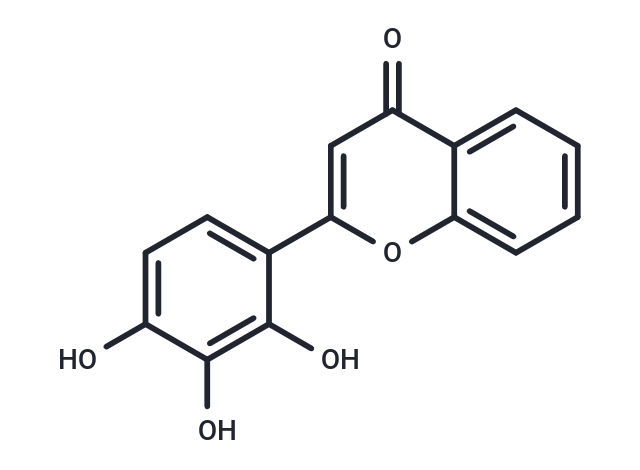Shopping Cart
Remove All Your shopping cart is currently empty
Your shopping cart is currently empty
2-D08 is a synthetic flavone that inhibits sumoylation, also inhibits Axl with an IC50 of 0.49 nM.2-D08 showed anti-aggregatory and neuroprotective effect.

| Pack Size | Price | USA Warehouse | Global Warehouse | Quantity |
|---|---|---|---|---|
| 2 mg | $35 | In Stock | In Stock | |
| 5 mg | $52 | In Stock | In Stock | |
| 10 mg | $89 | In Stock | In Stock | |
| 25 mg | $189 | In Stock | In Stock | |
| 50 mg | $297 | In Stock | In Stock | |
| 100 mg | $497 | In Stock | In Stock | |
| 200 mg | $723 | - | In Stock | |
| 1 mL x 10 mM (in DMSO) | $57 | In Stock | In Stock |
| Description | 2-D08 is a synthetic flavone that inhibits sumoylation, also inhibits Axl with an IC50 of 0.49 nM.2-D08 showed anti-aggregatory and neuroprotective effect. |
| Targets&IC50 | Axl:0.49 nM |
| In vitro | 2-D08 inhibits sumoylation of topoisomerase I in the breast cancer cell lines ZR-75-1 and BT-474.[1] It specifically disrupts the transfer of SUMO from the E2 enzyme (UBC9) thioester conjugate to the substrate. 2-D08 prevents amyloid-β (Aβ) (1-42) aggregation and Aβ-induced toxicity in PC12 cells. It also has antioxidant properties[2]. |
| Molecular Weight | 270.24 |
| Formula | C15H10O5 |
| Cas No. | 144707-18-6 |
| Smiles | Oc1ccc(c(O)c1O)-c1cc(=O)c2ccccc2o1 |
| Relative Density. | 1.548 g/cm3 (Predicted) |
| Color | Yellow |
| Appearance | Solid |
| Storage | Powder: -20°C for 3 years | In solvent: -80°C for 1 year | Shipping with blue ice/Shipping at ambient temperature. | |||||||||||||||||||||||||||||||||||
| Solubility Information | DMSO: 123.75 mg/mL (457.93 mM), Sonication is recommended. | |||||||||||||||||||||||||||||||||||
| In Vivo Formulation | 10% DMSO+40% PEG300+5% Tween 80+45% Saline: 5 mg/mL (18.5 mM), Sonication is recommended. Please add the solvents sequentially, clarifying the solution as much as possible before adding the next one. Dissolve by heating and/or sonication if necessary. Working solution is recommended to be prepared and used immediately. The formulation provided above is for reference purposes only. In vivo formulations may vary and should be modified based on specific experimental conditions. | |||||||||||||||||||||||||||||||||||
Solution Preparation Table | ||||||||||||||||||||||||||||||||||||
DMSO
| ||||||||||||||||||||||||||||||||||||
| Size | Quantity | Unit Price | Amount | Operation |
|---|

Copyright © 2015-2025 TargetMol Chemicals Inc. All Rights Reserved.